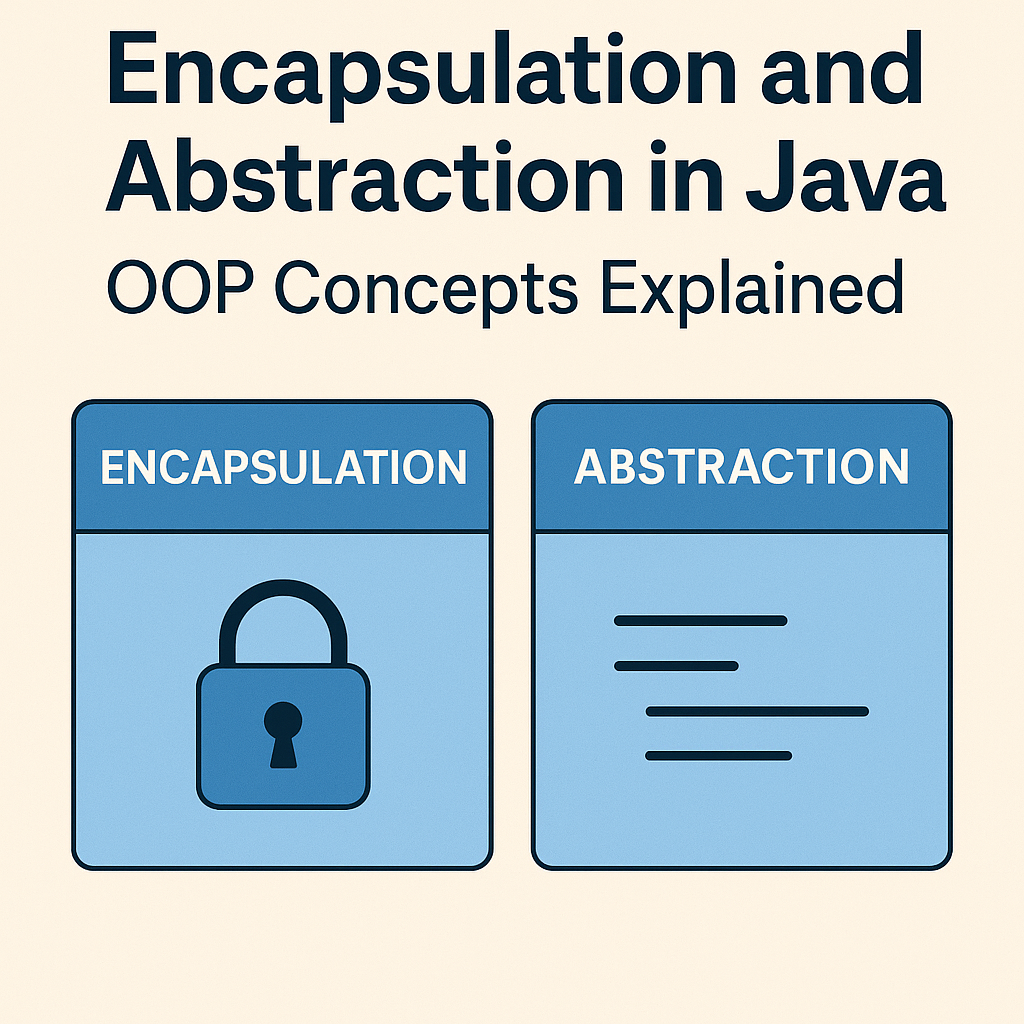Encapsulation and Abstraction in Java with Examples | OOPs Concepts
diagram on Encapsulation and Abstraction in Java
Encapsulation and Abstraction in Java | OOPs Concepts Explained
Introduction
In Java, Encapsulation and Abstraction are two foundational Object-Oriented Programming (OOP) concepts that play a crucial role in building secure, maintainable, and modular applications.
While both concepts are aimed at hiding complexity and improving code structure, they serve different purposes. In this guide, we will explore what encapsulation and abstraction mean, how they differ, and how they are implemented in Java with examples.

What is Encapsulation in Java?
Encapsulation is the process of wrapping data (variables) and code (methods) together as a single unit. In Java, this is done using classes, private access modifiers, and public getter/setter methods.
Key Points:
Data hiding: internal object details are hidden from outside classes.
Accessed via public methods only (getters and setters).
Promotes modularity and security.
Example:
public class Student {
private String name;
private int age;
// Getter
public String getName() {
return name;
}
// Setter
public void setName(String name) {
this.name = name;
}
public int getAge() {
return age;
}
public void setAge(int age) {
this.age = age;
}
}
In the above code, direct access to name and age is restricted. This is encapsulation.
What is Abstraction in Java?
Abstraction refers to hiding the internal implementation details and showing only the necessary functionalities to the user.
It is achieved using abstract classes and interfaces in Java.
Key Points:
Focuses on what an object does, not how it does it.
Helps reduce complexity.
Achieved via
abstractclasses andinterfaces.
Example:
abstract class Animal {
abstract void makeSound();
public void sleep() {
System.out.println("Sleeping...");
}
}
class Dog extends Animal {
@Override
void makeSound() {
System.out.println("Bark");
}
}
public class Main {
public static void main(String[] args) {
Animal dog = new Dog();
dog.makeSound();
dog.sleep();
}
}
In the above code, Animal defines the abstract method makeSound() without implementation. Dog provides the concrete implementation.
Difference Between Encapsulation and Abstraction
| Feature | Encapsulation | Abstraction |
|---|---|---|
| Definition | Binding data and methods together | Hiding internal details and showing only functionality |
| Focus | How it is done | What is done |
| Achieved by | Access modifiers, getters, setters | Abstract classes, interfaces |
| Purpose | Data hiding and security | Code readability and simplicity |
| Example | Private variables with public accessors | Abstract methods and classes |
Benefits of Encapsulation and Abstraction
Encapsulation:
Protects data from unauthorized access
Improves code maintainability
Makes the class modular
Abstraction:
Reduces programming complexity
Helps achieve loose coupling
Enhances scalability and flexibility
Conclusion
Both encapsulation and abstraction are integral parts of Java and OOPs. Encapsulation ensures that the internal state of an object is protected and accessed safely. Abstraction, on the other hand, simplifies the interface and allows developers to work with high-level logic.
Together, they contribute to writing robust, secure, and clean Java code.
FAQs
Q1. Can you have abstraction without encapsulation in Java?
Technically yes, but in practice, good abstraction often relies on encapsulation to hide implementation details.
Q2. Which is more important: abstraction or encapsulation?
Both are equally important. Abstraction hides complexity; encapsulation hides data.
Q3. Is interface an example of encapsulation?
No, an interface is a way to achieve abstraction. Encapsulation is more about restricting access via access modifiers.
Table of content
- Introduction to Java
- Java Basics
- Object-Oriented Programming (OOP) in Java
- Exception Handling in Java
- Types of Exceptions
- Try-Catch Block
- Finally Block and Throw/Throws
- Custom Exceptions
- Java Collections Framework
- Introduction to Collections
- List, Set, and Map Interfaces
- ArrayList vs LinkedList
- HashMap vs HashSet
- File Handling in Java
- Multithreading in Java
- Introduction to Threads
- Thread Lifecycle
- Creating Threads (Thread Class vs Runnable Interface)
- Synchronization and Deadlocks
- Networking in Java
- Java Networking Basics
- Socket Programming
- HTTP Requests in Java
- Java Database Connectivity (JDBC)
- Introduction to JDBC
- Connecting to MySQL Database
- Executing SQL Queries
- Using Prepared Statements
- Java Frameworks and Technologies
- Introduction to Spring Framework
- Hibernate ORM
- JavaFX for GUI Applications
- Java Interview Preparation
- Additional Java Resources
- Best Books to Learn Java
- Java Certification Guide
- Online Java Practice Platforms